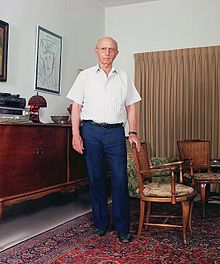Zvi Zamir
This article has multiple issues. Please help improve it or discuss these issues on the talk page. (Learn how and when to remove these template messages)
|
Zvi Zamir | |
|---|---|
| צבי זמיר | |
 Zamir in 1979 | |
| Born | Zvicka Zarzevsky 3 March 1925 |
| Died | 2 January 2024 (aged 98) Tel Aviv, Israel |
| Nationality | Israeli |
| Occupation | Director of Mossad |
| Espionage activity | |
| Allegiance | |
| Service branch | |
| Service years |
|
| Rank | Major general |
Zvi Zamir (Hebrew: צבי זמיר; born Zvicka Zarzevsky; 3 March 1925 – 2 January 2024) was a major general in the Israel Defense Forces and the director of the Mossad from 1968 to 1974.
Early life
Born in Poland on 3 March 1925,[1][2] Zamir immigrated with his family to the then British Mandate of Palestine when only seven months old. At the age of 18, Zamir began his military career, first as a soldier in the Haganah's Palmach, a unit that included future Israeli leaders such as Moshe Dayan and Yitzhak Rabin.
Intelligence career

IDF posts
During the
Mossad
During his tenure at the Mossad, he helped carry out an
Later life

Zamir was played by Ami Weinberg in Steven Spielberg's 2005 movie Munich.
His memoirs were published in
Zamir lived in Zahala, a neighborhood in the north of Tel Aviv. He died on 2 January 2024, at the age of 98.[4]
References
- ^ Profile of Zvi Zamir
- ^ "צבי זמיר". Archived from the original on 14 November 2020. Retrieved 3 April 2018.
- ISBN 978-0-19-934175-7.
- ^ Zvi Zamir, Mossad director during Yom Kippur War, dies at 98
Further reading
- "Preventive measures" Zamir interview in 2006.
- One Day in September, (1999), a documentary by Kevin Macdonald.
- Raviv, Dan and Melman, Yossi. Every Spy a Prince: The Complete History of Israel's Intelligence Community. Boston: Houghton Mifflin Company, 1990. ISBN 0-395-47102-8p. 179
External links
- Itamar Eichner, Mossad chief in Yom Kippur War: Tell CIA No. 2 to kiss my ass, Ynetnews, 17 December 2019

